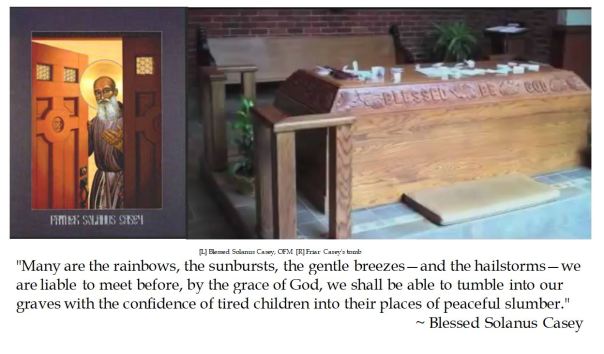"Barney" Solanus Casey is being beatified in a ceremony in Detroit, Michigan on November 18, 2017. Casey will be the second American born male to be beatified. Cardinal Angelo Amato, the head of the Congregation for the Cause of Saints will celebrate the Beatification Mass. Among the 70,000 in attendance at Ford Field will be four Cardinals and 218 Capuchin Friars.
The beatification of Fr. Solanus Casey is remarkable for a Wisconsin farm boy born in 1870. When Casey was called to the priesthood, he academically struggled at the seminary since instruction was in German. Thus, Casey was just ordained just a sacredos simplex and served in the early and mid-Twentieth Century as a lowly porter for the Capuchins friaries in Yonkers, Harlem, Manhattan and for 21 years in Detroit.
Despite not being able to give homilies or hear confessions, Fr. Casey had a remarkable impact. His reputation grew as a compassionate holy man who founded a soup kitchen in Detroit in 1929. Casey became well known as a priest who could relate with people. Fr. Casey was also known as an ordinary Detroiter who enjoyed Coney Island hot dogs and the Detroit Tigers.
Yet Fr. Casey drew people to him from his holy reputation and as a miracle worker who had a knack at helping get prayers answered. In his vocation as porter, Fr. Casey lent a listening ear and a caring heart to those who came to him. Fr. Casey would also offer visitors an opportunity to join a Capuchin Mass Memorial Society, in which he scrupulously wrote down their petitions and updated the log with how prayers were answered.
In 1954, Fr. Casey suffered a severe case of eczema over his entire body and was transfered back to Detroit to receive better medical case. Alas, complications set in and he died of untreatable psoriasis. It was estimated that 20,000 people showed up to mourn Fr. Casey's passing from this world. But when Fr. Casey's remains were exhumed in 1987, his corpse was incorrupted, save for a little decomposition around the elbows.
After Fr. Casey's death, lay friends of the Capuchins sought permission to create a Father Solanus Guild. As early as 1966, there were 24 reports of cures attributable to Fr. Solanus. Fr. Casey was named Venerable in 1995.
Normally, the Catholic beatification process involves the recognition of a miracle associated with a Servant of God. The Miracle which was recognized by the responsible Vatican dicastry is from 2012 when a Panamanian woman who visited Fr. Casey's tomb who suffered from an incurable skin disease but was healed by praying for Solanus Casey's intercession.


